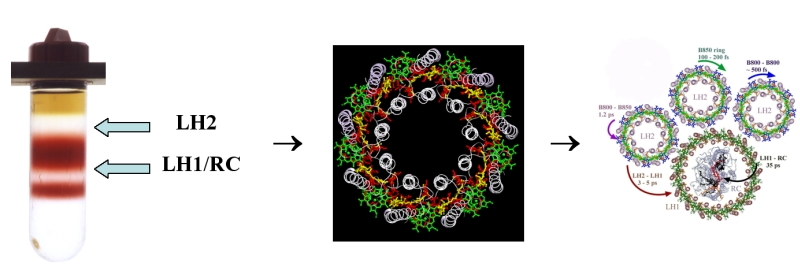 |
Bacterial antenna complex The study of the antenna complex from the purple bacterium Rhodopseudomonas acidophila is important in understanding how photo-synthesis works and in particular how solar radiation is captured by the antenna pigment molecules and then passed down the spectral gradient to the reaction centre where charge separation occurs. The very
first structure of the antenna complex, LH2, (shown below) was solved
in this laboratory in 1994 and has gained international recognition as
a milestone in understanding the key events in photosynthesis. |
Energy Transfer in Antenna Complexes
Photosynthesis starts with the absorption of solar radiation by antenna pigment molecules. In purple bacteria these chromophores, (bacteriochlorophyll a and carotenoid) are embedded in the membrane; they are non-covalently bound to apoproteins which have the ability to modulate the chromophore absorbing characteristics. The mechanism of energy transfer from the short- to long-wavelength absorbing pigments, is largely determined by the relative distances and orientations of the chromophores. Knowing the high resolution structure allows us to investigate in great detail the different mechanisms of energy transfer and the kinetics involved.
Lay summary
One of the first events to occur on Earth some 2500 million years ago was photosynthesis. Of course, at that time there were no green plants as the earth was still cooling down; there was no protective stratosphere; incoming radiation was much more intense than at present and the atmosphere was rich in methane and hydrogen. Despite these harsh conditions early photosynthesis began in the bacterial world where primitive (although relatively complex) mechanisms began to use this incoming solar power to survive. Relatives of these Proterozoic bacteria still survive today in polluted streams and rivers and survive by switching on their photosynthetic apparatus when the oxygen tension in the river decreases. Our main study is in photosynthetic non-sulphur purple bacteria and in particular the species Rhodopseudomonas acidophila. Although less complicated that green plants these bacteria afford a fascinating insight into the mechanism of energy transfer where solar radiation is captured by the antenna complexes and transformed into redox potential in the reaction centre.
Related publications (selected):
McDermott, G., Prince, S., Freer, A ., Lawlwss, A., Papiz, M., Isaacs, N.& Cogdell, R. (1995) Crystal structure of an integral membrane light-harvesting complex from photosynthetic bacteria. Nature , 374 , pp. 517-521
Freer, A. , Prince, S., Sauer, K., Papiz, M., Lawless, A., McDermott, G., Cogdell, R., and Isaacs, N. (1996) Pigment-pigment interactions and energy transfer in the antenna complex of the photosynthetic bacterium Rhodopseudomonas acidophila . Structure, 4 , No. 4 , pp. 449-462.
Prince,S.M, Mcdermott,G. Freer, A.A . Papiz, M.Z., Lawless, A.M. Cogdell,R.J. & Isaacs,N.W. (1999) Derivative manipulation in the structure solution of the integral membrane LH2 complex. Acta Cryst D55 , pp1428-1431.
Prince S, Howard T., Myles S, Wilkinson C, Papiz M, Freer A, Cogdell R & Isaacs, N (2003) Detergent Structure in Crystals of the Integral Membrane Light Harvesting Complex LH2 from Rhodopseudomonas acidophila Strain 10050. J. Mol. Biol . 326 , pp 307-315.Sauer, K., Cogdell, R., Prince, S., Freer, A., Isaacs, N. and Scheer, H. (1996) Structure based calculations of the optical spectra of the LH2 Bacteriochlorophyll-protein complexes from Rps. acidophila. Photochem. and Photobiol., 64 (3) pp.564-576.
Cogdell, R., Isaacs, N., Freer, A., Arrelano, J. Howard, T., Papiz., M., Lawless, A. and Prince, S. (1997) The Structure of the LH2 (B800-850) Complex from the Purple Photosynthetic Bacterium Rhodopseudomonas acidophila Strain 10050. Prog. Biophys. Molec. Biol., 68, No. 1, pp. 1-27.
